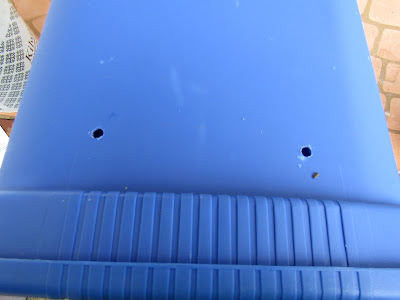Worms are the workhorses of the composting world.
They will go through discarded food bits and paper like nobody's business.
This project has been on my to-do list for quite some time.
Why make a worm bin?
Let me count the reasons!
1. It's a great way to recycle newspapers and scrap paper.
2. It's another way to use up daily kitchen scraps.
3. It's one of the least expensive ways to create compost.
4. It's simple and quick.
5. It gives a gardener rich castings to use as a fertilizer.
6. It's a fantastic way to teach kids about the composting cycle.
7. It's truly fascinating!
After downsizing many of our belongings,
our extra bins were saved for future projects,
this being one of them.
It's important that the bin not allow light through it,
as worms prefer to work their magic in the dark.
The only tool needed is a drill with a decent-sized drill bit.
Several holes were drilled into the bottom of the bin.
This allows for the aeration necessary to prevent the contents from getting saturated.
The worms also need air good circulation in order to do their job
and if desired, another lid can be placed underneath the bottom
to collect the liquid that drips down from the interior.
The drippings can be used directly on the garden.
Mother Nature at its best!
Mother Nature at its best!
Holes were also drilled into all four sides.
I didn't drill holes in the top because it will be outside,
and I didn't want rainwater getting into the bin.
The holes were not covered with screen, as I've seen some folks do.
I figure that if I am doing a good job of feeding the worms,
why would they want to leave?
If you feed them, they will stay!
Shredded newspapers and scrap paper were collected to add to the bin.
This will be moistened before adding the worms.
It's a good idea to enrich the bedding with a bit of soil,
which helps the worms with their digestion.
Food scraps are the final component and
can be added every few days,
but make sure to use a different spot with each supplemental feeding.
Follow these guidelines for allowable food products.
Follow these guidelines for allowable food products.
Another layer of shredded paper can go on top of the food.
Once you've added your wigglers, they will find their way to the food,
and keep eating and leaving you their castings.
Collect the castings in a container and use on the garden anytime,
no need to "cure" with this method.
Place the bin in a place that doesn't get direct sunlight.
I know some folks keep their bins inside the house,
but I don't think I'm quite there yet.
Our garage will serve as their new home in the winter.
For now though, the back porch will suffice.
For now though, the back porch will suffice.
I'm glad to have finally gotten this project completed.
Now, to find a local source for the worms
and watch 'em do their thing!
Another step toward self-sufficiency!










No comments:
Post a Comment
Thanks for taking the time to leave your thoughts!